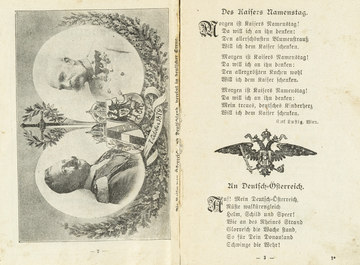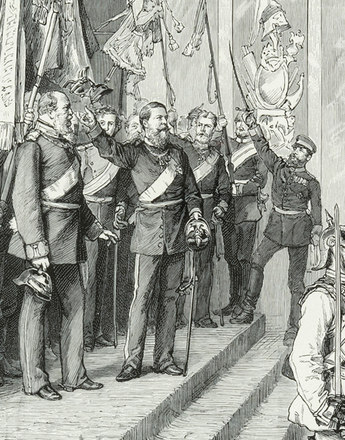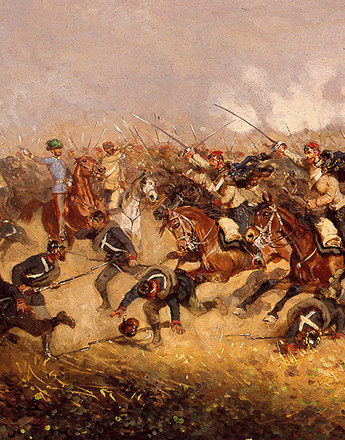The ‘Austrian identity’ of the German-speaking subjects of the Habsburg Monarchy was an intractably problematic phenomenon that is best described in terms of a ‘double identity’.
The development of an Austrian identity had its origins in the dynastic policy of the House of Habsburg that brought into being the complex known as the Austrian hereditary lands. After having initially been a somewhat fortuitous conglomeration of territories bound together only by a common ruling house, the hereditary lands developed in the course of the centuries into the core of the multi-ethnic Habsburg Monarchy.
From the eighteenth century onwards the Austrian lands experienced an independent cultural development that was strongly influenced by the unification programmes pursued under Maria Theresa and Joseph II, whose intention was to turn their heterogeneous patchwork of dominions into a unified Austrian state. In the process, Austrian cultural development was greatly influenced by the close contacts the German language group had with the other ethnic groups of the Habsburg Monarchy. The Austrian Germans were a special case in the overall context of German rise to nationhood.
This scenario also provides us with a clue to the inner dilemma of the German-Austrians in the nineteenth century. While the German rise to nationhood was generally characterized by a conflict between strong regional identities (Prussian, Saxon, Bavarian, Swabian etc.) and the feeling of belonging to the German nation in the cultural sense of the word, the conflict was even more complicated in the case of the German-Austrians. As well as being pulled in two directions by their regional identity (Tyrolean, Viennese, German-Bohemian, Danube Swabian or whatever) and their feeling of attachment to the ‘deutsche Nation’ as a whole, they were also – in their own eyes at least – the ‘people of state’ and upholders of the whole idea of the Habsburg Monarchy.
The Austrian identity was put to a severe test in 1871 when a unified German nation-state was founded in the form of the German Reich – without the Austrian Germans. The ‘Austriandom’ that was subsequently developed as a conscious alternative to the ‘Germandom’ of the Reich was marked by a strange mixture of a proud (and at times somewhat pathetic) insistence on Austria’s leading position in the German-speaking world and a feeling of having been excluded that was compounded by a certain inferiority complex in the face of the dynamic development of the young and vigorous German nation-state.
The quest for Austrian identity was made even more problematic by the successful emancipation and self-confident political representation of the other nationalities of the multi-ethnic Monarchy, which the German-Austrians perceived as a threat. Around 1900, the challenges to their hegemony in the state led to a strengthening of German nationalism and a weakening of Habsburg-Austrian patriotism. The change of identity from Austrian to German often took place very rapidly and in many cases was experienced as being something in the nature of a personal conversion.
At the outbreak of war in 1914 the state attempted to harness a revival of ‘Austriandom’ to the bandwagon of chauvinistic patriotic euphoria. One symbolic expression of this endeavour was the decree of 1915 introducing ‘Austria’ as the official designation for Cisleithania. Similarly, special emphasis was now laid on what was ‘Austrian’ in art and culture; the sense of Austrian identity was fostered by the drawing up of a canon of typically Austrian phenomena, notably Catholicism and loyalty to the Habsburg dynasty; and epochs and styles such as the Baroque and the Biedermeier were labelled as the classic expressions of Austriandom, with – in a tendency that was to continue long after the fall of the Habsburg Monarchy – Austrian music being regarded as the indisputable crowning glory of the European musical tradition.
Translation: Peter John Nicholson
Bruckmüller, Ernst: Österreichbegriff und Österreich-Bewußtsein in der franzisko-josephinischen Epoche, in: Plaschka, Richard Georg (Hrsg): Was heißt Österreich? Inhalt und Umfang des Österreichbegriffs vom 10. Jahrhundert bis heute (=Archiv für österreichische Geschichte 136), Wien 1995, S. 225–288
Hanisch, Ernst: Der lange Schatten des Staates. Österreichische Gesellschaftsgeschichte im 20. Jahrhundert [Österreichische Geschichte 1890–1990, hrsg. von Herwig Wolfram], Wien 2005
Křen, Jan: Dvě století střední Evropy [Zwei Jahrhunderte Mitteleuropas], Praha 2005
Rumpler, Helmut: Eine Chance für Mitteleuropa. Bürgerliche Emanzipation und Staatsverfall in der Habsburgermonarchie [Österreichische Geschichte 1804–1914, hrsg. von Herwig Wolfram], Wien 2005
-
Chapters
- The German-Austrians in the Habsburg Monarchy
- German Austrians or Austrian Germans?
- Holding the Monarchy together: The German-Austrians as the guarantors of Habsburg statehood
- In search of the Fatherland: The genesis of the German nation
- To join or not to join? Austria and the process of German unification
- Fear of losing hegemony: The German-Austrians in the Austrian multi-national state
- The radical German nationalists and their attitude to the Habsburg Monarchy
- The concept of ‘German Central Europe’







